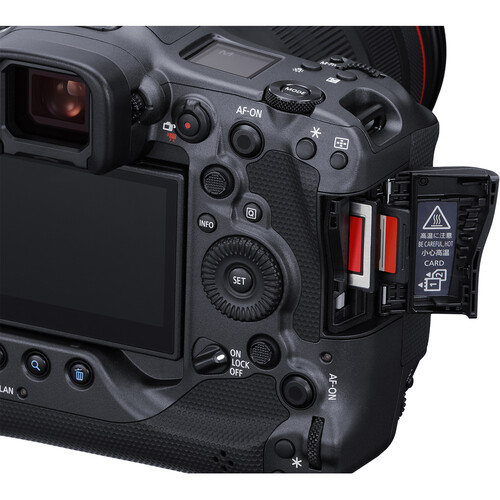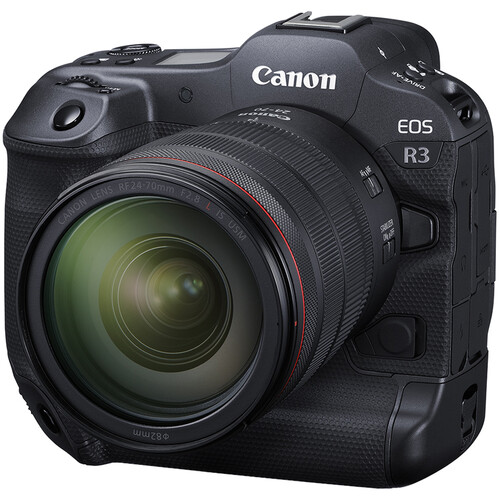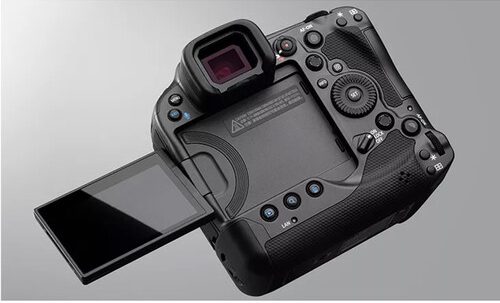The Canon EOS R3 is one of the most exciting mirrorless cameras to hit the market in recent years. With blistering speed, remarkable autofocus, and rugged durability, it’s built with professionals in mind. No matter if you’re photographing fast-paced sports, unpredictable wildlife, or cinematic video scenes, the is designed to meet the challenge head-on.
This isn’t just a camera with top-tier specs—it’s a true workhorse. It blends DSLR-style handling with mirrorless innovation, making it a go-to choice for working pros who demand speed and reliability.
In this in-depth Canon EOS R3 review, I’ll explore everything from the camera’s design and image quality to its real-world performance in photo and video scenarios. Whether you’re deciding if it’s worth the investment or just curious about what makes this camera so unique, I’ve got you covered!
Table of Contents
- Canon EOS R3 Design and Build Quality
- Canon EOS R3 Sensor and Image Quality
- Canon EOS R3 Autofocus Performance
- Canon EOS R3 Burst Shooting and Speed
- Canon EOS R3 Video Features and Quality
- Canon EOS R3 Connectivity and Workflow
- Canon EOS R3 Battery Life and Real-World Usability
- Canon EOS R3 Pros and Cons
- Final Verdict
- Frequently Asked Questions
Canon EOS R3 Design and Build Quality

The Canon EOS R3 looks and feels like a tool designed for professionals. Its integrated vertical grip gives it the same handling characteristics as Canon’s flagship DSLRs. The magnesium alloy chassis is strong, weather-sealed, and ready to handle tough environments.
Canon has put serious thought into ergonomics. The camera fits naturally in your hand, whether you’re shooting horizontally or vertically. The top LCD screen, customizable buttons, and intuitive menu layout make for a familiar and efficient shooting experience. If you’ve used the 1D X Mark III, transitioning to the EOS R3 is seamless.
A nice feature is the smart controller built into the AF-ON button, allowing you to shift focus points with your thumb. And the fully articulating 4.15m-dot 3.2-inch touchscreen is bright, responsive, and a great addition for low-angle or selfie-style shots.
Sensor and Image Quality

At the heart of the Canon EOS R3 is a 24.1MP backside-illuminated stacked CMOS sensor. While some might wish for more resolution, this sensor is all about speed, dynamic range, and low-light performance. The detail it captures is more than enough for most pro applications, from prints to digital publication.
The camera’s colors are classic Canon—warm, pleasing, and natural. Skin tones look great straight out of the camera, and files hold up well under post-processing. Dynamic range is excellent, offering flexibility in both highlights and shadows.
In low light, the EOS R3 shines. With clean results up to ISO 12,800 and usable files even beyond that (the ISO range is 100-102400, expandable up to 50-204800), it’s perfect for challenging lighting scenarios. The DIGIC X processor does an outstanding job of reducing noise while preserving detail, too.
Canon EOS R3 Autofocus Performance

The Canon EOS R3 features Canon’s most advanced autofocus system to date. Dual Pixel CMOS AF II covers nearly 100% of the frame and has 1,053 AF points, offering lightning-fast subject detection and tracking. Whether you’re photographing athletes, birds in flight, or moving vehicles, the AF system is almost telepathic.
One of the camera’s best features is Eye Control AF. This tech allows you to select a focus point just by looking at it in the viewfinder. While it takes some calibration and practice, it’s surprisingly accurate and a true game-changer in fast-paced environments.
Animal and vehicle tracking are equally impressive. The EOS R3 can recognize and stick with subjects even in complex scenes, making it a dream for wildlife and motorsports photographers. It locks on quickly and doesn’t let go.
Canon EOS R3 Burst Shooting and Speed

If speed is your top priority, the Canon EOS R3 won’t disappoint. It delivers up to 30 frames per second using the electronic shutter, with full AF and AE tracking. Even with the mechanical shutter, you get a solid 12 fps.
Buffer performance is outstanding. The buffer is basically unlimited when shooting HEIF or JPEG files. But even when shooting in RAW, the R3’s buffer accommodates nearly 300 images on a UHS-II memory card. That kind of performance ensures you won’t miss the moment, even during intense action.
The stacked sensor architecture helps reduce rolling shutter, too, making the electronic shutter viable even in fast-moving scenes. It’s one of the fastest mirrorless cameras ever made—and it shows.
Keep Reading: 4 Impressive Canon EOS R3 Specs
Canon EOS R3 Video Features and Quality
As Jared Polin discusses in the video above, the Canon EOS R3 is a hybrid powerhouse. It shoots 6K RAW at 60fps and offers 4K oversampled video from that 6K feed, ensuring exceptional detail and clarity. You also get 10-bit 4:2:2 internal recording with Canon Log 3, making it a viable tool for professional video work.
Unlike the EOS R5, the R3 doesn’t suffer from overheating during extended video recording. There are no time limits, and the camera handles heat management impressively. This makes it ideal for event videographers and documentarians alike.
Autofocus in video mode is smooth and reliable, and the IBIS (in-body image stabilization) pairs beautifully with stabilized RF lenses. You can shoot handheld with confidence, even when moving.
Canon EOS R3 Connectivity and Workflow

The Canon EOS R3 is built with professionals in mind, and that extends to connectivity. It includes dual card slots—one CFexpress Type B and one SD UHS-II—offering flexible media options and backup workflows.
Wi-Fi, Bluetooth, USB-C, Ethernet, and GPS are all onboard. This makes it easy to transmit images, tether to a laptop, or embed location data during shoots. FTP and tethered shooting options are robust and reliable.
If you’re working in high-pressure environments like sports or photojournalism, the R3’s fast transfer speeds and remote control features are a huge advantage.
Canon EOS R3 Battery Life and Real-World Usability

Hero Photo by DANIEL HAY on Unsplash
The Canon EOS R3 uses the LP-E19 battery—the same one found in Canon’s top DSLR bodies. Battery life is excellent, lasting around 620 shots per charge depending on usage (according to CIPA). For video, it offers plenty of endurance without the need for external power.
In the field, the camera handles exceptionally well. It’s large, yes, but perfectly balanced with RF telephoto lenses. The deep grip, customizable buttons, and quick menus keep you shooting confidently and efficiently.
Canon EOS R3 Pros and Cons

Pros:
- Blazing-fast 30fps burst shooting
- Incredible autofocus with Eye Control AF
- Pro-level build with integrated grip
- Top-tier 6K and 4K video capabilities
- Excellent low-light and dynamic range performance
Cons:
- 24MP resolution may be limiting for large-format printing
- High price point
- Bigger and heavier than other mirrorless bodies
- No 8K video
Final Verdict

The Canon EOS R3 is the ultimate hybrid tool for professionals who demand speed, durability, and uncompromising autofocus. While it might not have the pixel count of the R5 Mark II, what it offers in real-world performance more than makes up for it.
If you’re a sports, wildlife, or photojournalism pro—or even an enthusiast who wants the best—this camera delivers. And if the retail price gives you pause, buying used is a smart alternative. I highly recommend checking out MPB for used Canon EOS R3 bodies.
I’ve personally purchased gear from MPB many times over the years and trust them completely. Their inventory changes regularly, and they often have Canon EOS R3 cameras in excellent condition. MPB also offers a seven-day return window and a six-month warranty on most items, so you can shop with peace of mind.
The Canon EOS R3 is more than just another camera—it’s a professional tool built to perform under pressure. And with a reliable used option, it’s more accessible than ever.
Frequently Asked Questions

Is the Canon EOS R3 better than the EOS R5?
The Canon EOS R3 is better for action and speed, while the EOS R5 Mark II is better for resolution and detailed work. Choose based on your shooting needs.
Does the Canon R3 overheat during video recording?
No, the R3 has excellent heat management and no recording limits, making it ideal for long-form video production.
How does Eye Control AF work?
It tracks where you’re looking in the viewfinder and allows you to move the AF point with your eye. After calibration, it’s surprisingly intuitive.
What lenses are compatible with the EOS R3?
All RF lenses are natively supported. EF lenses also work flawlessly with Canon’s RF to EF adapter.
Is the Canon EOS R3 suitable for beginners?
Not really. It’s designed for professionals or advanced users. Beginners are better off with a Canon R6 or R7.
Can I use the Canon EOS R3 for landscape or portrait photography?
Absolutely. While it’s geared toward speed, its dynamic range and image quality make it a great choice for landscapes and portraits too.
Our articles might have affiliate links and the occasional sponsored content, but don’t sweat it – if you buy something, we get a little kickback at no extra cost to you, and we only hype products we truly believe in!
Learn More:
- Canon EOS-1D X Mark III Review: A Powerhouse for Professionals
- Canon EOS R5 Mark II Review: A Powerhouse for Photographers and Videographers
Hero Photo by DANIEL HAY on Unsplash

